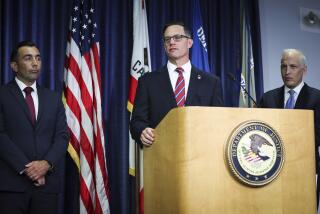Worst Spy Loss Felt in Navy Sub Communication
- Share via
WASHINGTON — Damage done by the alleged spy ring headed by John A. Walker Jr. will cost “many millions of dollars and a great many man-years” to repair, Navy Secretary John F. Lehman Jr. said Tuesday in presenting the first comprehensive assessment of the worst espionage scandal in Navy history.
The greatest loss was suffered in the field of “secure,” or encoded, Teletype and voice communications to and from submarines, said the Navy’s top officer, Adm. James D. Watkins, who appeared with Lehman at a Pentagon news conference.
Manuals about those systems, and messages carried on them, were accessible to the Walker ring, and the Navy assumes in its “worst case” analysis that all the information was passed on to the Soviet Union, Watkins said.
Little on Missiles
However, he said the Soviets were given “very little information” of lasting value about U.S. submarines, missiles and sensing devices. For example, he said, there is no indication that the Soviets can detect U.S. missile-firing submarines--a key part of the nation’s nuclear deterrent--any better now as a result of information they may have received.
Watkins, who is chief of naval operations, characterized the overall damage to national security as “very serious . . . but not catastrophic” and predicted that future developments in the case would not significantly change this evaluation.
As part of a broader security overhaul, Lehman announced that the Navy immediately will reduce by 10% the number of uniformed and civilian personnel cleared for access to classified information and will reinstate tighter rules for handling such material. Currently, about 900,000 persons have such access.
He also called for random lie detector tests of naval personnel to detect spying--much like urinalysis tests that have been highly successful in identifying drug users in the military. Questions would be limited to espionage activities, he said.
In a related development, Defense Secretary Caspar W. Weinberger announced that he has ordered a 10% cut in security clearances held by 4.3 million persons in all military services and among defense contractors. He also ordered a special commission “to identify . . . vulnerabilities or weaknesses” in Pentagon security practices.
Weinberger’s announcement, dated Monday, includes several measures also outlined Tuesday by Lehman. However, Weinberger did not advocate using lie detectors in random checks.
Asks Death Penalty
Lehman, meanwhile, also called for broader actions, including cuts in the number of Soviet citizens allowed in the United States as diplomats and U.N. employees; amendment of the military code of justice to make espionage specifically an offense during peacetime, and amendment of federal law to permit the death penalty for espionage.
The Navy’s damage assessment is being conducted by a 35-member team in the Office of Naval Intelligence. It has been examining all documents and messages available to Walker and other suspects in the spy ring, reporting findings immediately to operating fleet commanders so that corrective action can be speeded, as well as reporting to Navy headquarters.
Watkins said the Navy believes it has established the sorts of materials available to the Walker group and has confidence that no “new exposes would change the assessment” on its key points.
New Designs Planned
Communications was “the most serious area of compromise,” he said, adding: “Some technical design communication information has probably been lost.” However, new designs are being accelerated and equipment will be produced quickly to replace the compromised equipment, he said.
Information apparently given to the Soviets was “largely operational in nature”--dealing, for example, with daily ship movements--and decreased in value with time, he said. But the information did “fill voids” in Soviet knowledge about U.S. systems and activities and confirmed U.S. tactics and procedures that the Soviets observed in exercises and maneuvers.
Using this information, the Soviets can devise better training and countermeasure techniques to cope with U.S. naval aircraft and surface ship tactics, he said. In anti-submarine warfare, “the Soviets know of our ability to find and target their submarines, which is a real area of potential giveaway by the Walkers,” he added.
However, the Soviets also learned that they “must work harder still to overcome the U.S. technical advantage” in building quieter and better submarines. “We have witnessed them gaining on us in the technical differential, which was significant 10 years ago but has been shrinking. Perhaps Walker contributed to that shrinkage,” Watkins said.
Finally, regarding the strategic missile-carrying submarines, most of the Walker data on these key subs came from the period of 1962-69. Tactics, equipment, submarines and missiles have all changed markedly since then, he said, and indeed continue to change.
Based on 25 years of studying whether the Soviets can detect U.S. missile subs on patrol, “including the most recent patrols,” Watkins said, “there is no indication that the Soviets have broken the code of how to detect” these U.S. vessels. “We remain convinced that our (missile submarine) force is still 100% survivable,” he said.
More to Read
Sign up for Essential California
The most important California stories and recommendations in your inbox every morning.
You may occasionally receive promotional content from the Los Angeles Times.










